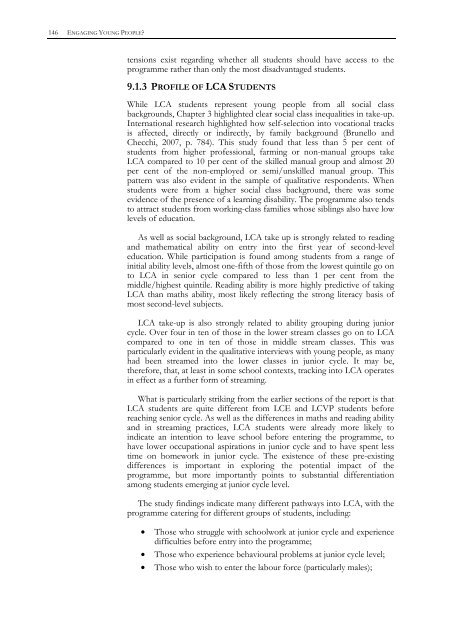Student Experiences of the Leaving Certificate Applied Programme
Student Experiences of the Leaving Certificate Applied Programme
Student Experiences of the Leaving Certificate Applied Programme
You also want an ePaper? Increase the reach of your titles
YUMPU automatically turns print PDFs into web optimized ePapers that Google loves.
146 ENGAGING YOUNG PEOPLE?tensions exist regarding whe<strong>the</strong>r all students should have access to <strong>the</strong>programme ra<strong>the</strong>r than only <strong>the</strong> most disadvantaged students.9.1.3 PROFILE OF LCA STUDENTSWhile LCA students represent young people from all social classbackgrounds, Chapter 3 highlighted clear social class inequalities in take-up.International research highlighted how self-selection into vocational tracksis affected, directly or indirectly, by family background (Brunello andChecchi, 2007, p. 784). This study found that less than 5 per cent <strong>of</strong>students from higher pr<strong>of</strong>essional, farming or non-manual groups takeLCA compared to 10 per cent <strong>of</strong> <strong>the</strong> skilled manual group and almost 20per cent <strong>of</strong> <strong>the</strong> non-employed or semi/unskilled manual group. Thispattern was also evident in <strong>the</strong> sample <strong>of</strong> qualitative respondents. Whenstudents were from a higher social class background, <strong>the</strong>re was someevidence <strong>of</strong> <strong>the</strong> presence <strong>of</strong> a learning disability. The programme also tendsto attract students from working-class families whose siblings also have lowlevels <strong>of</strong> education.As well as social background, LCA take up is strongly related to readingand ma<strong>the</strong>matical ability on entry into <strong>the</strong> first year <strong>of</strong> second-leveleducation. While participation is found among students from a range <strong>of</strong>initial ability levels, almost one-fifth <strong>of</strong> those from <strong>the</strong> lowest quintile go onto LCA in senior cycle compared to less than 1 per cent from <strong>the</strong>middle/highest quintile. Reading ability is more highly predictive <strong>of</strong> takingLCA than maths ability, most likely reflecting <strong>the</strong> strong literacy basis <strong>of</strong>most second-level subjects.LCA take-up is also strongly related to ability grouping during juniorcycle. Over four in ten <strong>of</strong> those in <strong>the</strong> lower stream classes go on to LCAcompared to one in ten <strong>of</strong> those in middle stream classes. This wasparticularly evident in <strong>the</strong> qualitative interviews with young people, as manyhad been streamed into <strong>the</strong> lower classes in junior cycle. It may be,<strong>the</strong>refore, that, at least in some school contexts, tracking into LCA operatesin effect as a fur<strong>the</strong>r form <strong>of</strong> streaming.What is particularly striking from <strong>the</strong> earlier sections <strong>of</strong> <strong>the</strong> report is thatLCA students are quite different from LCE and LCVP students beforereaching senior cycle. As well as <strong>the</strong> differences in maths and reading abilityand in streaming practices, LCA students were already more likely toindicate an intention to leave school before entering <strong>the</strong> programme, tohave lower occupational aspirations in junior cycle and to have spent lesstime on homework in junior cycle. The existence <strong>of</strong> <strong>the</strong>se pre-existingdifferences is important in exploring <strong>the</strong> potential impact <strong>of</strong> <strong>the</strong>programme, but more importantly points to substantial differentiationamong students emerging at junior cycle level.The study findings indicate many different pathways into LCA, with <strong>the</strong>programme catering for different groups <strong>of</strong> students, including:• Those who struggle with schoolwork at junior cycle and experiencedifficulties before entry into <strong>the</strong> programme;• Those who experience behavioural problems at junior cycle level;• Those who wish to enter <strong>the</strong> labour force (particularly males);

















